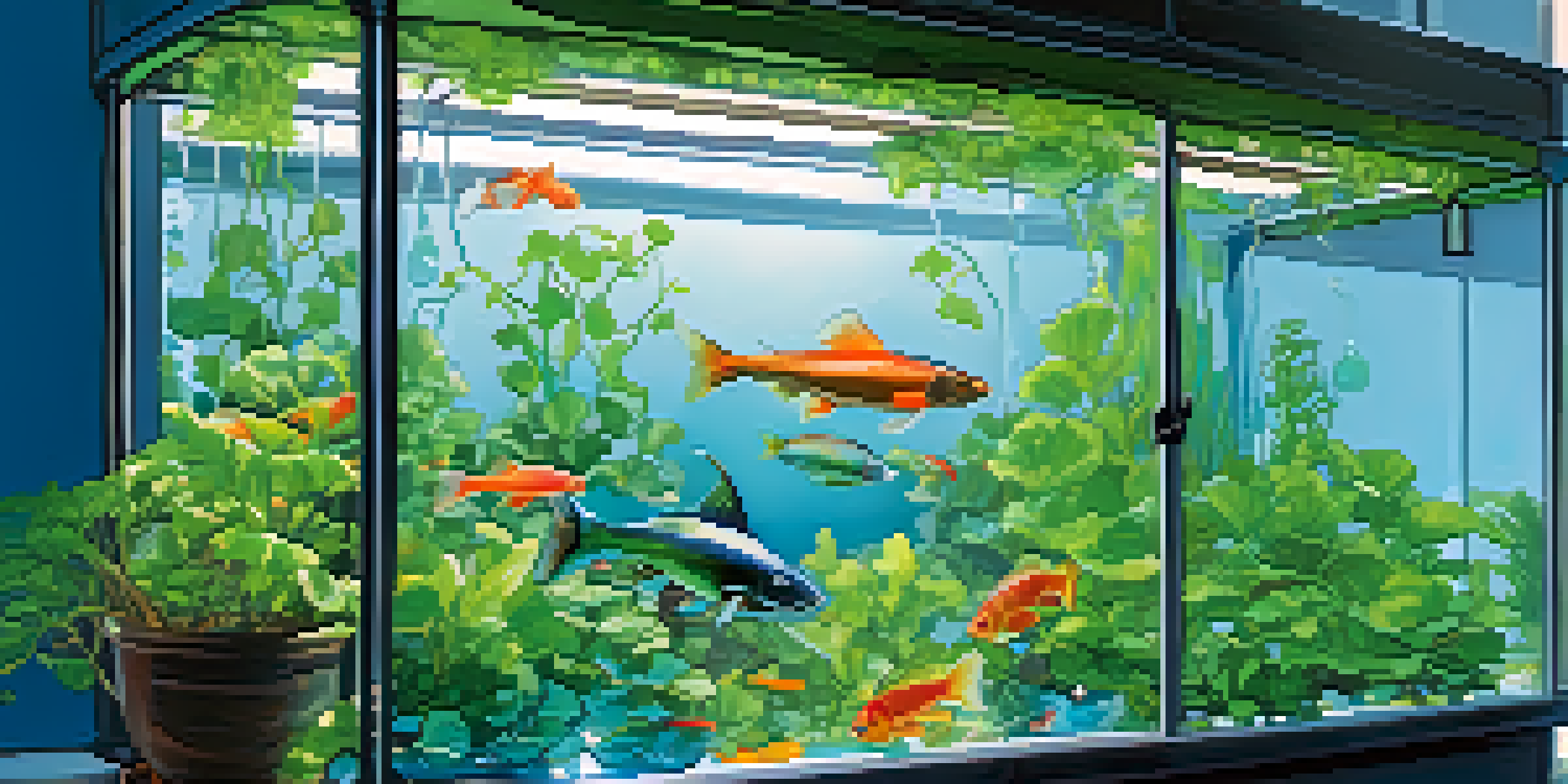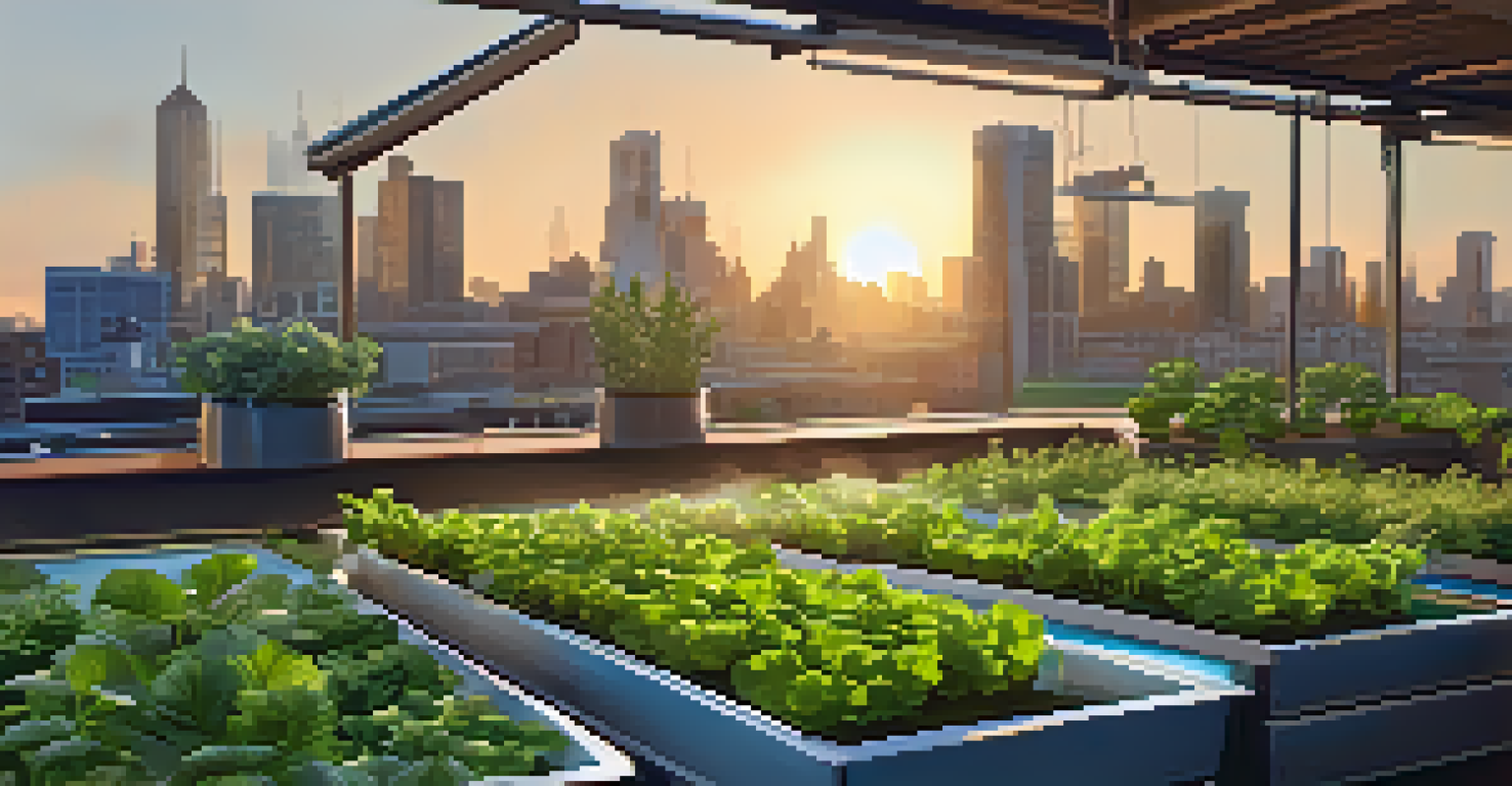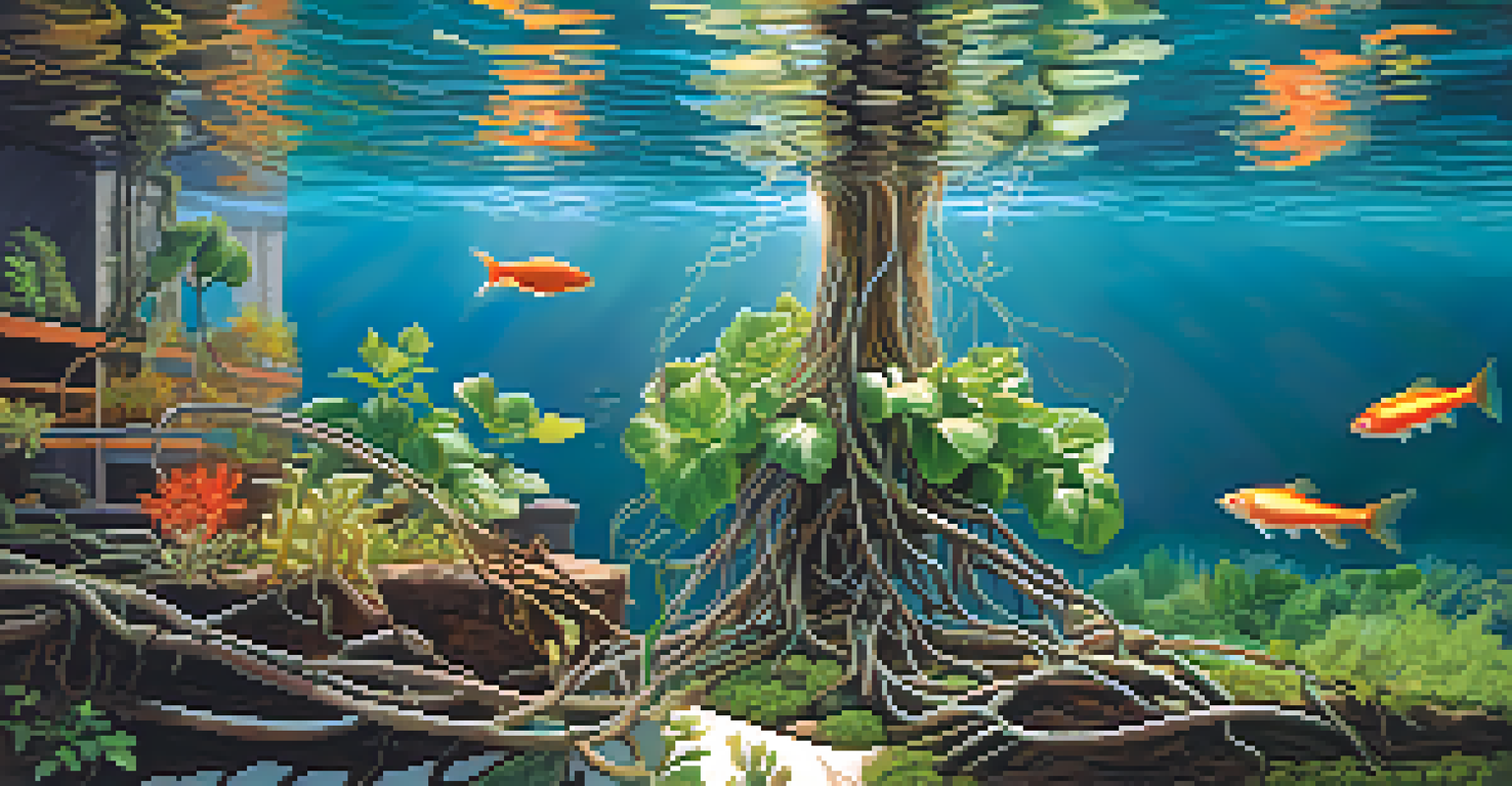Aquaponics and Water Conservation: A Sustainable Approach

Understanding Aquaponics: A Unique Ecosystem
Aquaponics is a fascinating agricultural system that combines aquaculture (raising fish) and hydroponics (growing plants in water). This symbiotic relationship allows fish waste to nourish plants, while plants help filter the water for the fish. Imagine a miniature ecosystem where both plants and fish thrive together, creating a balanced environment. This method not only optimizes space but also significantly reduces the need for chemical fertilizers.
Water is the driving force of all nature.
In this closed-loop system, water is recirculated, which means that the amount of water used is drastically less than traditional gardening methods. For instance, while conventional farming can use over 2,000 gallons of water to produce a single pound of vegetables, aquaponics can use as little as 10% of that amount. This efficiency is crucial, especially in areas facing water scarcity.
By understanding aquaponics, we can see how it represents a shift toward more sustainable practices in agriculture. It's a way to utilize resources efficiently while still producing high-quality food. As more people become aware of this innovative approach, we might just see a transformation in how we think about food production and resource management.
The Importance of Water Conservation in Agriculture
Water conservation is becoming increasingly vital as global populations grow and climate change alters weather patterns. Agriculture is one of the largest consumers of freshwater, accounting for nearly 70% of global water use. Therefore, finding ways to reduce this consumption is essential for sustainability. As we face prolonged droughts and water shortages, traditional agriculture methods are under scrutiny.

Innovative practices like aquaponics can help bridge the gap between food production and water conservation. By using significantly less water than traditional farming, aquaponics stands out as a practical solution. In fact, studies show that aquaponic systems can yield up to ten times more food per gallon of water compared to conventional methods.
Aquaponics: A Water-Saving Solution
Aquaponics uses up to 90% less water than traditional farming by recirculating water in a closed-loop system.
The shift toward water-efficient farming practices is not just beneficial for the environment; it can also enhance food security. As we adopt sustainable techniques like aquaponics, we’re not only conserving water but also ensuring that we can continue to feed the world's growing population. This dual benefit illustrates why water conservation should be a priority in agricultural discussions.
How Aquaponics Reduces Water Usage
Aquaponics operates on a simple yet effective principle: water is reused in a continuous cycle. In a typical aquaponic system, water from the fish tank is pumped to the plants, where it provides essential nutrients. After passing through the plant roots, this water is then filtered and returned to the fish tank. This closed-loop system drastically minimizes water loss, making it an ideal method for water conservation.
Sustainability is not a destination; it is a way of life.
For example, in a traditional farm, water is often lost through evaporation, runoff, and overwatering. In contrast, aquaponics captures and recycles water, resulting in minimal waste. This efficiency means that aquaponic systems can thrive in regions where water is scarce, offering a lifeline for communities facing water challenges.
Additionally, aquaponics can be set up in various environments, including urban areas where space is limited. By utilizing rooftops and other underused spaces, aquaponics not only conserves water but also promotes local food production. This adaptability makes aquaponics an appealing option for both home gardeners and commercial operations.
The Benefits of Aquaponics for Local Communities
Aquaponics has the potential to empower local communities by providing fresh, nutritious food while conserving water. In urban areas, where access to fresh produce can be limited, aquaponics allows residents to grow their own food sustainably. This localized approach not only reduces the carbon footprint associated with transporting food but also enhances food security.
Moreover, aquaponics systems can create jobs and stimulate local economies. By establishing community gardens or commercial farms, individuals can learn valuable skills in sustainable agriculture. This knowledge can be particularly impactful in areas with high unemployment rates, fostering entrepreneurship and innovation.
Empowering Communities with Food
Aquaponics can enhance food security in urban areas by allowing residents to grow fresh produce sustainably.
Additionally, the educational aspect of aquaponics cannot be overlooked. Schools and community organizations can implement aquaponic systems as hands-on learning experiences. This engagement not only teaches valuable lessons about ecology and sustainability but also inspires the next generation to prioritize environmental stewardship.
Challenges Facing Aquaponics and Water Conservation
While aquaponics presents exciting opportunities for sustainable agriculture, it is not without its challenges. Setting up an aquaponic system can require a significant initial investment, which may deter some potential growers. Additionally, maintaining the balance between fish and plant populations can be complex, requiring knowledge and experience to achieve optimal results.
Furthermore, there can be a steep learning curve associated with aquaponics. New growers must familiarize themselves with the intricacies of fish care, plant nutrition, and system maintenance. This complexity can lead to frustration for those who expect immediate results, potentially dissuading them from pursuing this sustainable practice.
Despite these challenges, ongoing advancements in aquaponic technology and education are helping to make these systems more accessible. As more resources become available to aspiring aquaponic farmers, the potential for widespread adoption grows. By addressing the barriers to entry, we can unlock the full benefits of aquaponics for water conservation and sustainable food production.
The Role of Technology in Advancing Aquaponics
Technology is playing a pivotal role in enhancing the efficiency and effectiveness of aquaponic systems. From automated monitoring systems that track water quality to advanced nutrient delivery methods, innovation is making aquaponics easier to manage. These technological advancements allow growers to focus more on food production and less on troubleshooting.
For instance, smart sensors can provide real-time data on the health of both fish and plants. By monitoring parameters such as pH levels, temperature, and nutrient concentrations, growers can make informed decisions to optimize their systems. This data-driven approach not only improves efficiency but also increases the likelihood of a successful harvest.
Technology Enhances Aquaponics
Advancements in technology are making aquaponic systems easier to manage and more efficient, paving the way for widespread adoption.
Moreover, the rise of vertical farming and urban aquaponics showcases how technology is reshaping food production. These systems can be implemented in small spaces, allowing for food growth even in densely populated areas. As technology continues to evolve, the possibilities for aquaponics as a sustainable agricultural practice are boundless.
Future Prospects for Aquaponics and Water Conservation
The future of aquaponics looks promising as awareness of water conservation and sustainability grows. With increasing water scarcity and the need for sustainable food systems, aquaponics offers a viable solution. More farmers, researchers, and entrepreneurs are exploring this innovative approach, leading to exciting developments in the field.
As aquaponics continues to gain traction, we can expect more community initiatives, educational programs, and research efforts dedicated to improving these systems. This collective movement will not only enhance our understanding of aquaponics but also showcase its potential for addressing global challenges like food insecurity and water scarcity.

In conclusion, aquaponics stands out as a beacon of hope for sustainable agriculture and water conservation. By harnessing the power of this unique ecosystem, we can pave the way for a more sustainable future. Embracing aquaponics is not just about growing food; it's about nurturing our planet and ensuring that future generations have access to the resources they need to thrive.